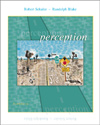 |  Perception, 4/e Robert Sekuler,
Brandeis University
Randolph Blake,
Vanderbilt University
Seeing a Three-Dimensional World
Chapter OverviewThis chapter has examined sources of information, monocular and binocular, used by perception to specify the 3D layout of objects in the visual environment. We have emphasized that 3D vision is computed automatically and effortlessly, without conscious deliberation. We have also seen that depth perception influences perceived size, resulting in size constancy as well as certain illusions of size. This connection between illusion and constancy is similar to a connection seen earlier, for lightness perception (Chapter 3). Although we have emphasized distance information in this chapter, depth cues' more general contribution should not be overlooked. As David Marr (1982) has pointed out, depth serves to define objects relative to their backgrounds - helping the viewer to distinguish those objects and appreciate their shapes. In the next chapter we take up another aspect of vision - motion - that serves the same purpose and others as well. |
|



 2002 McGraw-Hill Higher Education
2002 McGraw-Hill Higher Education